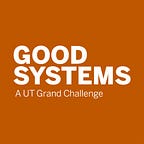Robots in Real Time
By Mary Huber
When we think of the robots in practical use today, the most common are stationary robots that help assemble parts in automotive factories or can assist in performing delicate medical surgeries.
Building a robot that can move within the human world with all its unpredictable variables, like self-driving cars, is oftentimes more difficult.
Researchers and students led by Associate Professor Junfeng Jiao at The University of Texas at Austin have been taking that challenge — crafting robots that students can call up via an iOS app to perform contactless deliveries on campus, much like Uber and Lyft.
“The adjective ‘robotic’ people often take to mean doing the same thing over and over again in a controlled way,” says Peter Stone, a professor in UT’s Department of Computer Science and director of Texas Robotics. “But the challenge of robotics today is to get robots out of these sort of repetitive, doing-the-same-thing-all-the-time interactions toward robots that can exist in the real world with dynamic features of people walking around, unpredictable effects, and being able to be robust toward unforeseen circumstances.”
“In many ways, this is a grand challenge of robotics,” he adds.
UT students and researchers have built robots of this kind that can deliver lemonade on campus. They rely on a long-term autonomous navigation system that takes into account the permanent features of the environment, like buildings. However, they use on-board cameras and LiDAR sensing technology to gain real-time updates of changes in the environment, like construction, cars, or people riding bikes.
“A key challenge of such a project is the ability to be resilient to changes over time. As you might imagine, the route the robot takes one day might look visually quite distinct from the route it takes the next day,” says Computer Science Assistant Professor Joydeep Biswas in this month’s Robotics Panel, which debuted the new system.
In November, the team will partner with UT dining services to set up a lemonade stand on campus. Students will be able to order a glass of the refreshing beverage via an iOS app and have the drink delivered to them by the robots. Users will be able to watch every step of the delivery from pick-up to drop-off, as well as see past orders, submit complaints, or offer feedback.
These types of contactless deliveries have become even more important during the COVID-19 pandemic to reduce contact between individuals and curb the spread of disease.
The project is funded by Good Systems, a UT grand challenge that seeks to create ethical AI systems, including—in this case—deciding how to effectively mix robots with humans in the built environment.
Hear researchers, including Biswas (Computer Science); Jiao (Architecture and Good Systems Executive Chair); Associate Professor Luis Sentis (Aerospace Engineering); and Assistant Professor of Practice Justin Hart (Computer Science) talk about the project and see a live demo of a delivery in action for yourself.
Please join us on this journey.
Good Systems is a research grand challenge at The University of Texas at Austin. We’re a team of information and computer scientists, robotics experts, engineers, humanists and philosophers, policy and communication scholars, architects, and designers. Our goal over the next eight years is to design AI technologies that benefit society. Follow us on Twitter, join us at our events, and come back to our blog for updates.
